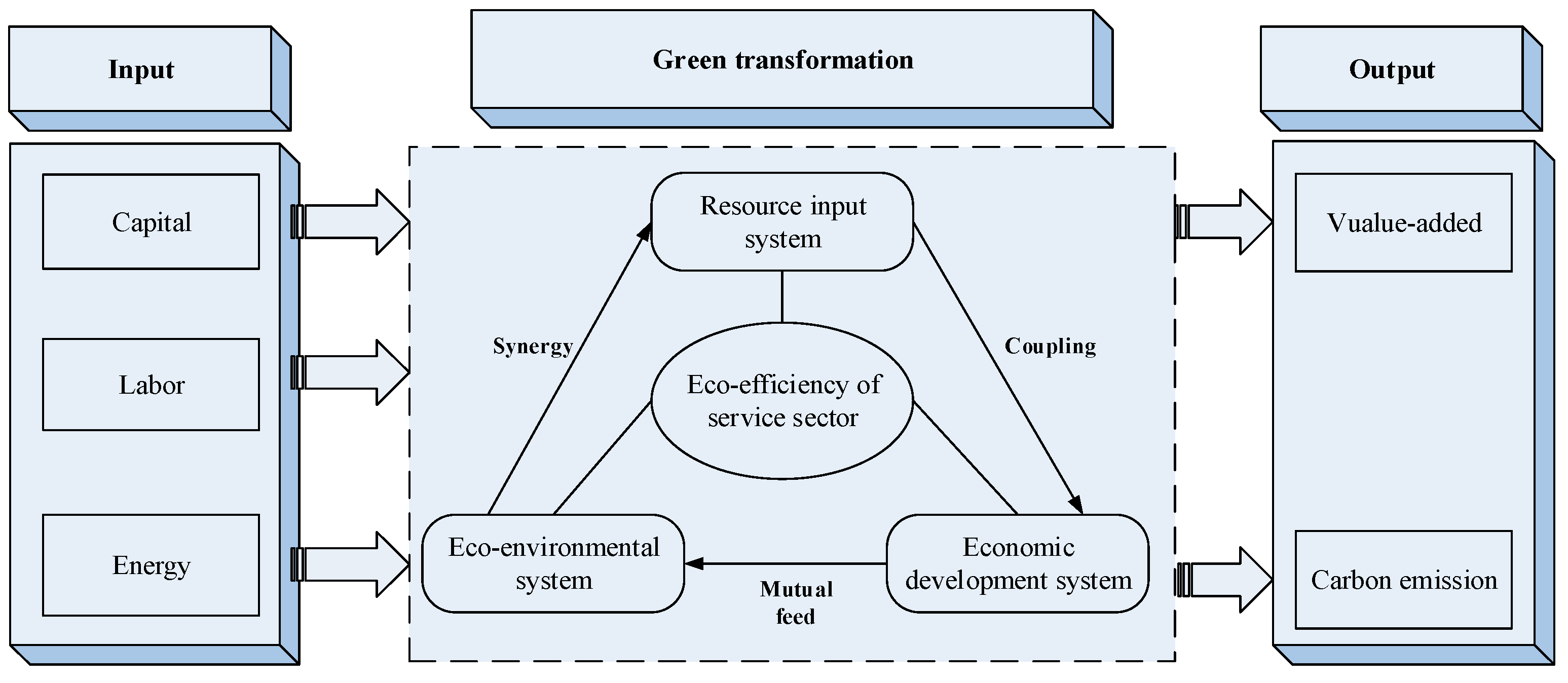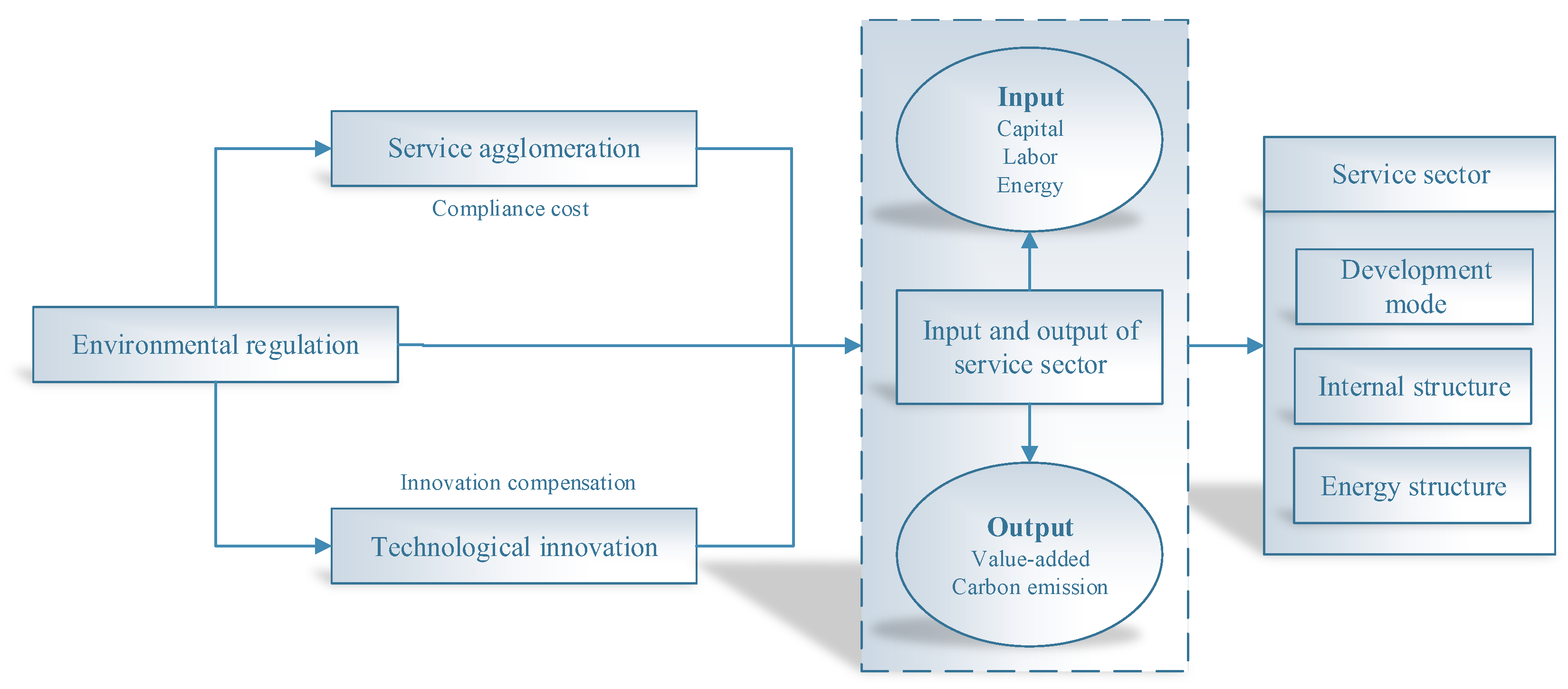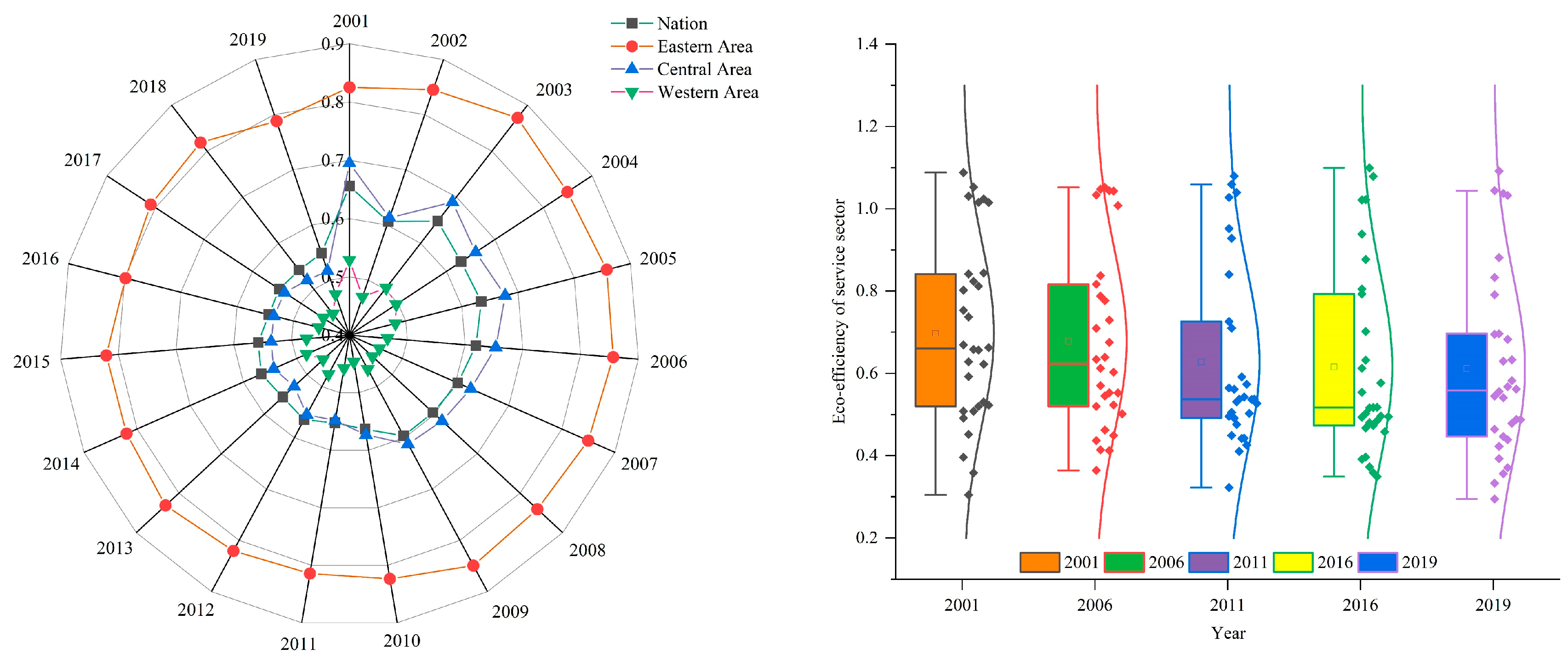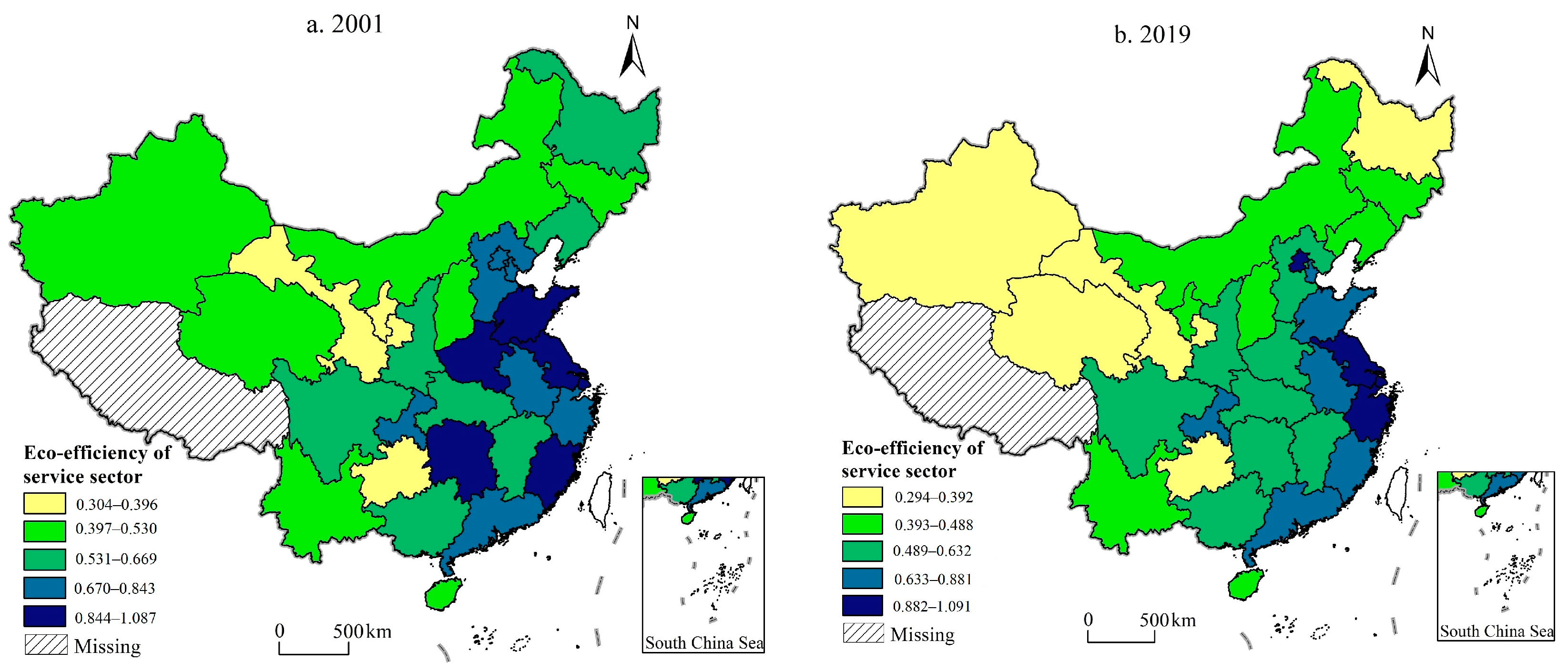Analysis of the Effect of Environmental Regulation on Eco-Efficiency of Service Sector
Abstract
1. Introduction
2. Literature Review
2.1. The Concept of EESS
2.2. Low-Carbon Development of Service Sector
3. Research Hypothesis
3.1. Direct Role of Environmental Regulation in the EESS
3.2. The Mediating Effect of Service Agglomeration on the EESS
3.3. The Mediating Effect of Technological Innovation on the EESS
4. Methodology and Data
4.1. Methodology
4.1.1. Super-EBM Model
4.1.2. Benchmark Model
4.1.3. Mediating Effect Model
4.1.4. Threshold Model
4.2. Variables and Indicators Selection
4.2.1. Indicators Regarding EESS
4.2.2. Explained Variable and Core Explanatory Variable
4.2.3. Control Variable
4.2.4. Mediating Variable
4.2.5. Threshold Variable
4.3. Data Sources
5. Result and Analysis
5.1. Spatiotemporal Evolution of EESS
5.2. Benchmark Regression
5.3. Heterogeneity Analysis
5.4. Robustness Check
5.5. Further Analysis
5.5.1. Indirect Effect
5.5.2. Threshold Effect
6. Discussion
7. Conclusions
7.1. Main Conclusions
7.2. Policy Implications
7.3. Limitations and Outlook
Author Contributions
Funding
Institutional Review Board Statement
Informed Consent Statement
Data Availability Statement
Conflicts of Interest
References
- Cui, S.; Wang, Z. The impact and transmission mechanisms of financial agglomeration on eco-efficiency: Evidence from the organization for economic co-operation and development economies. J. Clean. Prod. 2023, 392, 136219. [Google Scholar] [CrossRef]
- Yang, L.; Yang, Y.; Zhou, Y.; Shi, X. Research the synergistic carbon reduction effects of sulfur dioxide emissions trading policy. J. Clean. Prod. 2024, 447, 141483. [Google Scholar] [CrossRef]
- Wang, M.; Kuusi, T. Trade flows, carbon leakage, and the EU Emissions Trading System. Energy Econ. 2024, 134, 107556. [Google Scholar] [CrossRef]
- Li, K.; Qi, S.; Shi, X. Environmental policies and low-carbon industrial upgrading: Heterogenous effects among policies, sectors, and technologies in China. Technol. Forecast. Soc. Change 2023, 191, 122468. [Google Scholar] [CrossRef]
- Wang, F.; Wu, M.; Du, X. Does industrial upgrading improve eco-efficiency? Evidence from China’s industrial sector. Energy Econ. 2023, 124, 106774. [Google Scholar] [CrossRef]
- Zhang, G.; Lin, B. Impact of structure on unified efficiency for Chinese service sector—A two-stage analysis. Appl. Energy 2018, 231, 876–886. [Google Scholar] [CrossRef]
- Wang, Z.; Cheng, Z. Spatiotemporal interaction characteristics and transition mechanism of carbon intensity in China’s service industry under the targets of carbon peak and carbon neutrality. Acta Geogr. Sin. 2023, 78, 54–70. (In Chinese) [Google Scholar]
- Guo, L.; Li, P.; Zhang, J.; Xiao, X.; Peng, H. Do socio-economic factors matter? A comprehensive evaluation of tourism eco-efficiency determinants in China based on the Geographical Detector Model. J. Environ. Manag. 2022, 320, 115812. [Google Scholar] [CrossRef] [PubMed]
- Yang, B.; Zhang, Z.; Wu, H. Detection and attribution of changes in agricultural eco-efficiency within rapid urbanized areas: A case study in the Urban agglomeration in the middle Reaches of Yangtze River, China. Ecol. Indic. 2022, 144, 109533. [Google Scholar] [CrossRef]
- Yang, H.; Wang, X.; Bin, P. Agriculture carbon-emission reduction and changing factors behind agricultural eco-efficiency growth in China. J. Clean. Prod. 2022, 334, 130193. [Google Scholar] [CrossRef]
- Revollar, S.; Meneses, M.; Vilanova, R.; Vega, P.; Francisco, M. Eco-efficiency assessment of control actions in wastewater treatment plants. Water 2021, 13, 612. [Google Scholar] [CrossRef]
- Koskela, M.; Vehmas, J. Defining eco-efficiency: A case study on the Finnish forest industry. Bus. Strategy Environ. 2012, 21, 546–566. [Google Scholar] [CrossRef]
- Zhu, F.; Fang, Y.; Yi, S.; Yu, H. Eco-efficiency of grassland-based animal husbandry and its determinants in the source regions of the Yangtze and Yellow Rivers. China Environ. Sci. 2017, 37, 310–318. [Google Scholar]
- Matsumoto, K.i.; Chen, Y. Industrial eco-efficiency and its determinants in China: A two-stage approach. Ecol. Indic. 2021, 130, 108072. [Google Scholar] [CrossRef]
- Gutowski, T.G. The efficiency and eco-efficiency of manufacturing. Int. J. Nanomanufacturing 2010, 6, 38–45. [Google Scholar] [CrossRef]
- Ruschi Mendes Saade, M.; G. da Silva, M.; Gomes, V.; Gumez Franco, H.; Schwamback, D.; Lavor, B. Material eco-efficiency indicators for Brazilian buildings. Smart Sustain. Built Environ. 2014, 3, 54–71. [Google Scholar] [CrossRef]
- Tenente, M.; Henriques, C.; da Silva, P.P. Eco-efficiency assessment of the electricity sector: Evidence from 28 European Union countries. Econ. Anal. Policy 2020, 66, 293–314. [Google Scholar] [CrossRef]
- Liu, Y.; Zhu, J.; Li, E.Y.; Meng, Z.; Song, Y. Environmental regulation, green technological innovation, and eco-efficiency: The case of Yangtze river economic belt in China. Technol. Forecast. Soc. Change 2020, 155, 119993. [Google Scholar] [CrossRef]
- Yu, X.; Xu, H.; Lou, W.; Xu, X.; Shi, V. Examining energy eco-efficiency in China’s logistics industry. Int. J. Prod. Econ. 2023, 258, 108797. [Google Scholar] [CrossRef]
- Teng, Z. Spatial differentiation and driving factors of green total factor productivity in China’ s service industry. J. Quant. Technol. Econ. 2020, 37, 23–41. (In Chinese) [Google Scholar] [CrossRef]
- Wang, X.; Xu, L.; Ye, Q.; He, S.; Liu, Y. How does services agglomeration affect the energy efficiency of the service sector? Evidence from China. Energy Econ. 2022, 112, 106159. [Google Scholar] [CrossRef]
- Gan, C.; Wang, K. Research on spatiotemporal pattern evolution and configuration improvement of ecological efficiency of service industry in Yangtze River Economic Belt. Res. Environ. Sci. 2024, 37, 835–848. (In Chinese) [Google Scholar] [CrossRef]
- Schaltegger, S.; Sturm, A. Ökologische rationalität: Ansatzpunkte zur ausgestaltung von ökologieorientierten managementinstrumenten. Die Unternehm. 1990, 44, 273–290. [Google Scholar]
- WBCSD. Leadership for Improved Economic and Environmental Performance; WBCSD: Geneva, Switzerland, 1996; pp. 3–16. [Google Scholar]
- Kuosmanen, T.; Kortelainen, M. Measuring eco-efficiency of production with data envelopment analysis. J. Ind. Ecol. 2005, 9, 59–72. [Google Scholar] [CrossRef]
- Alcántara, V.; Padilla, E. Input–output subsystems and pollution: An application to the service sector and CO2 emissions in Spain. Ecol. Econ. 2009, 68, 905–914. [Google Scholar] [CrossRef]
- Farreny, R.; Gabarrell, X.; Rieradevall, J. Energy intensity and greenhouse gas emission of a purchase in the retail park service sector: An integrative approach. Energy Policy 2008, 36, 1957–1968. [Google Scholar] [CrossRef]
- Collard, F.; Fève, P.; Portier, F. Electricity consumption and ICT in the French service sector. Energy Econ. 2005, 27, 541–550. [Google Scholar] [CrossRef]
- Gan, C.; Wang, K.; Voda, M. Decoupling relationship between carbon emission and economic development in the service sector: Case of 30 provinces in China. Environ. Sci. Pollut. Res. 2022, 29, 63846–63858. [Google Scholar] [CrossRef] [PubMed]
- Piaggio, M.; Alcántara, V.; Padilla, E. The materiality of the immaterial: Service sectors and CO2 emissions in Uruguay. Ecol. Econ. 2015, 110, 1–10. [Google Scholar] [CrossRef]
- Krackeler, T.; Schipper, L.; Sezgen, O. Carbon dioxide emissions in OECD service sectors: The critical role of electricity use. Energy Policy 1998, 26, 1137–1152. [Google Scholar] [CrossRef]
- Xing, R.; Hanaoka, T.; Kanamori, Y.; Masui, T. Estimating energy service demand and CO2 emissions in the Chinese service sector at provincial level up to 2030. Resour. Conserv. Recycl. 2018, 134, 347–360. [Google Scholar] [CrossRef]
- Zhang, L. Model projections and policy reviews for energy saving in China’s service sector. Energy Policy 2013, 59, 312–320. [Google Scholar] [CrossRef][Green Version]
- Fang, C.-Y.; Hu, J.-L.; Lou, T.-K. Environment-adjusted total-factor energy efficiency of Taiwan’s service sectors. Energy Policy 2013, 63, 1160–1168. [Google Scholar] [CrossRef] [PubMed]
- Lin, B.; Zhang, G. Energy efficiency of Chinese service sector and its regional differences. J. Clean. Prod. 2017, 168, 614–625. [Google Scholar] [CrossRef]
- Teng, Z.; Hu, Z.; Jiang, X. Study on the difference and covergence of carbon productivity in China’s service industry. J. Quant. Technol. Econ. 2017, 34, 78–94. (In Chinese) [Google Scholar] [CrossRef]
- Wang, R.; Hao, J.-X.; Wang, C.; Tang, X.; Yuan, X. Embodied CO2 emissions and efficiency of the service sector: Evidence from China. J. Clean. Prod. 2020, 247, 119116. [Google Scholar] [CrossRef]
- He, F.; Hu, Y. Non-linear effects of environmental regulation on urban sustainable development efficiency. China Popul. Resour. Environ. 2022, 32, 84–95. (In Chinese) [Google Scholar]
- Porter, M.E.; Linde, C.v.d. Toward a new conception of the environment-competitiveness relationship. J. Econ. Perspect. 1995, 9, 97–118. [Google Scholar] [CrossRef]
- Sinn, H.-W. Public policies against global warming: A supply side approach. Int. Tax Public Financ. 2008, 15, 360–394. [Google Scholar] [CrossRef]
- Lanoie, P.; Patry, M.; Lajeunesse, R. Environmental regulation and productivity: Testing the porter hypothesis. J. Product. Anal. 2008, 30, 121–128. [Google Scholar] [CrossRef]
- Cui, S.; Wang, Y.; Zhu, Z.; Zhu, Z.; Yu, C. The impact of heterogeneous environmental regulation on the energy eco-efficiency of China’s energy-mineral cities. J. Clean. Prod. 2022, 350, 131553. [Google Scholar] [CrossRef]
- Marshall, A. The principles of economics. Political Sci. Q. 1920, 77, 519–524. [Google Scholar]
- Glaeser, E.L.; Kahn, M.E. The greenness of cities: Carbon dioxide emissions and urban development. J. Urban Econ. 2010, 67, 404–418. [Google Scholar] [CrossRef]
- Brakman, S.; Garretsen, H.; Gigengack, R.; Van Marrewijk, C.; Wagenvoort, R. Negative feedbacks in the economy and industrial location. J. Reg. Sci. 1996, 36, 631–651. [Google Scholar] [CrossRef]
- Fan, C.C.; Scott, A.J. Industrial agglomeration and development: A survey of spatial economic issues in East Asia and a statistical analysis of Chinese regions. Econ. Geogr. 2003, 79, 295–319. [Google Scholar] [CrossRef]
- Gan, C.; Voda, M. Can green finance reduce carbon emission intensity? Mechanism and threshold effect. Environ. Sci. Pollut. Res. 2023, 30, 640–653. [Google Scholar] [CrossRef] [PubMed]
- Jia, R.; Shao, S.; Yang, L. High-speed rail and CO2 emissions in urban China: A spatial difference-in-differences approach. Energy Econ. 2021, 99, 105271. [Google Scholar] [CrossRef]
- Tone, K.; Tsutsui, M. An epsilon-based measure of efficiency in DEA—A third pole of technical efficiency. Eur. J. Oper. Res. 2010, 207, 1554–1563. [Google Scholar] [CrossRef]
- Xu, Q.; Zhong, M.; Li, X. How does digitalization affect energy? International evidence. Energy Econ. 2022, 107, 105879. [Google Scholar] [CrossRef]
- Wang, H.; Dong, C.; Liu, Y. Beijing direct investment to its neighbors: A pollution haven or pollution halo effect? J. Clean. Prod. 2019, 239, 118062. [Google Scholar] [CrossRef]
- Sun, Y.; Gao, P.; Razzaq, A. How does fiscal decentralization lead to renewable energy transition and a sustainable environment? Evidence from highly decentralized economies. Renew. Energy 2023, 206, 1064–1074. [Google Scholar] [CrossRef]
- Cheng, Y.; Awan, U.; Ahmad, S.; Tan, Z. How do technological innovation and fiscal decentralization affect the environment? A story of the fourth industrial revolution and sustainable growth. Technol. Forecast. Soc. Change 2021, 162, 120398. [Google Scholar] [CrossRef]
- Zheng, Z.; Liu, X.; Wang, Y. Has environmental regulation improved China’s energy efficiency? Analysis based on panel threshold model. J. Hainan Univ. (Humanit. Soc. Sci.) 2023, 42, 1–10. (In Chinese) [Google Scholar] [CrossRef]
- IPCC. Guidelines for National Greenhouse Gas Inventories; IPCC: Hayama, Japan, 2006.
- Chen, S.; Chen, D. Air pollution, government regulations and high-quality economic development. Econ. Res. J. 2018, 53, 20–34. [Google Scholar]
- Wang, J.; Dong, K.; Hochman, G.; Timilsina, G.R. Factors driving aggregate service sector energy intensities in Asia and Eastern Europe: A LMDI analysis. Energy Policy 2023, 172, 113315. [Google Scholar] [CrossRef]
- Dong, K.; Sun, R.; Hochman, G.; Li, H. Energy intensity and energy conservation potential in China: A regional comparison perspective. Energy 2018, 155, 782–795. [Google Scholar] [CrossRef]
- Jorgenson, D.W.; Wilcoxen, P.J. Environmental regulation and US economic growth. RAND J. Econ. 1990, 21, 314–340. [Google Scholar] [CrossRef]
- Barbera, A.J.; McConnell, V.D. The impact of environmental regulations on industry productivity: Direct and indirect effects. J. Environ. Econ. Manag. 1990, 18, 50–65. [Google Scholar] [CrossRef]
- Huang, X.; Tian, P. How does heterogeneous environmental regulation affect net carbon emissions: Spatial and threshold analysis for China. J. Environ. Manag. 2023, 330, 117161. [Google Scholar] [CrossRef] [PubMed]
- Yu, Q.; Li, M.; Li, Q.; Wang, Y.; Chen, W. Economic agglomeration and emissions reduction: Does high agglomeration in China’s urban clusters lead to higher carbon intensity? Urban Clim. 2022, 43, 101174. [Google Scholar] [CrossRef]
- Voda, M.; Kithiia, S.; Jackiewicz, E.; Du, Q.; Sarpe, C.A. Geosystems ‘pathways to the future of Sustainability. Sci. Rep. 2019, 9, 14446. [Google Scholar] [CrossRef] [PubMed]
- Verhoef, E.; Nijkamp, P. Externalities in urban sustainability: Environmental versus localization-type agglomeration externalities in a general spatial equilibrium model of a single-sector monocentric industrial city. Ecol. Econ. 2002, 40, 157–179. [Google Scholar] [CrossRef]
- Brännlund, R.; Lundgren, T. Environmental policy without costs? A review of the Porter hypothesis. Int. Rev. Environ. Resour. Econ. 2009, 3, 75–117. [Google Scholar] [CrossRef]
- Lanoie, P.; Laurent-Lucchetti, J.; Johnstone, N.; Ambec, S. Environmental policy, innovation and performance: New insights on the Porter hypothesis. J. Econ. Manag. Strategy 2011, 20, 803–842. [Google Scholar] [CrossRef]




| First-Level Indicator | Second-Level Indicator | Third-Level Indicator | Unit |
|---|---|---|---|
| Input indicator | Capital | Capital stock of the service sector | 100 million |
| Labor | The number of employees from the service sector | Person | |
| Energy | Total energy consumption | 1011 KJ | |
| Output indicator | Desirable output | The value-added of the service sector | 100 million |
| Undesirable output | Carbon emissions from the service sector | 10 thousand t |
| Type | Variable | Mean | Obs. | Std. Dev | Min | Max | VIF |
|---|---|---|---|---|---|---|---|
| Dependent variable | lnEffi | −0.486 | 570 | 0.335 | −1.222 | 0.117 | — |
| Core independent variable | lnEr | −1.573 | 570 | 2.017 | −10.996 | 0.949 | 1.41 |
| Mediating variable | lnAgg | −0.181 | 570 | 0.151 | −0.343 | 0.635 | — |
| lnTech | 9.623 | 570 | 1.722 | 4.820 | 13.601 | — | |
| Threshold variable | lnEco | 10.188 | 570 | 0.828 | 7.791 | 12.008 | — |
| Control variable | lnEs | −2.618 | 570 | 1.428 | −8.654 | −0.293 | 1.50 |
| lnUrb | −0.792 | 570 | 0.582 | −5.317 | −0.060 | 1.34 | |
| lnOpe | −1.715 | 570 | 1.004 | −4.368 | 0.543 | 1.61 | |
| lnKl | 1.327 | 570 | 0.745 | −0.562 | 3.275 | 1.20 | |
| lnFis | 0.077 | 570 | 0.460 | −3.652 | 1.556 | 1.86 |
| Variable | lnEffi | |||||
|---|---|---|---|---|---|---|
| (1) | (2) | (3) | (4) | (5) | (6) | |
| lnEr | −0.032 *** (0.010) | −0.029 *** (0.010) | −0.028 *** (0.010) | −0.034 *** (0.011) | −0.031 *** (0.011) | −0.031 *** (0.011) |
| lnEs | −0.010 (0.007) | −0.010 (0.007) | −0.009 (0.007) | −0.010 (0.007) | −0.010 (0.007) | |
| lnUrb | −0.077 ** (0.033) | −0.067 ** (0.033) | −0.059 * (0.034) | −0.059 * (0.034) | ||
| lnOpe | −0.048 ** (0.020) | −0.044 ** (0.021) | −0.043 ** (0.021) | |||
| lnKl | −0.028 (0.026) | −0.027 (0.027) | ||||
| lnFis | −0.001 (0.022) | |||||
| Cons_ | −0.468 *** (0.029) | −0.485 *** (0.031) | 0.562 *** (0.045) | −0.652 *** (0.059) | −0.619 *** (0.067) | −0.619 *** (0.067) |
| Province FE | Yes | Yes | Yes | Yes | Yes | Yes |
| Time FE | Yes | Yes | Yes | Yes | Yes | Yes |
| R2 | 0.019 | 0.015 | 0.013 | 0.385 | 0.334 | 0.336 |
| N | 570 | 570 | 570 | 570 | 570 | 570 |
| Variable | Different Areas | Different Periods | |||
|---|---|---|---|---|---|
| Eastern Area | Central Area | Western Area | 2001~2010 | 2011~2019 | |
| (1) | (2) | (3) | (4) | (5) | |
| lnEr | −0.027 ** (0.013) | −0.001 (0.031) | −0.084 *** (0.028) | −0.043 * (0.022) | −0.001 (0.012) |
| Control variable | Yes | Yes | Yes | Yes | Yes |
| Cons_ | −0.190 *** (0.063) | −1.186 *** (0.233) | −1.574 *** (0.288) | −0.647 *** (0.114) | −0.597 *** (0.095) |
| Province FE | YES | YES | YES | YES | YES |
| Time FE | YES | YES | YES | YES | YES |
| R2 | 0.338 | 0.471 | 0.179 | 0.592 | 0.461 |
| N | 228 | 171 | 171 | 300 | 270 |
| Variable | Super-SBM Model | Lag One Period | Eliminating Years | Scale Efficiency | Endogeneity |
|---|---|---|---|---|---|
| (1) | (2) | (3) | (4) | (5) | |
| L.lnEffi | 0.771 *** (0.048) | ||||
| lnEr | −0.049 *** (0.015) | −0.032 *** (0.011) | −0.034 *** (0.014) | −0.010 * (0.005) | |
| L.lnEr | −0.025 ** (0.012) | ||||
| Control variable | Yes | Yes | Yes | Yes | Yes |
| Cons_ | −0.608 *** (0.091) | −0.651 *** (0.070) | −0.604 *** (0.066) | −0.410 *** (0.071) | −0.016 (0.027) |
| Province FE | Yes | Yes | Yes | Yes | |
| Time FE | Yes | Yes | Yes | No | |
| AR (1) test | 0.001 | ||||
| AR (2) test | 0.332 | ||||
| Sargan test | 0.135 | ||||
| Hausma test | 21.13 *** | ||||
| R2 | 0.255 | 0.241 | 0.280 | 0.013 | |
| N | 570 | 540 | 510 | 570 | 540 |
| Variable | (1) | (2) | (3) | (4) |
|---|---|---|---|---|
| lnAgg | lnEffi | lnTech | lnEffi | |
| lnEr | 0.025 *** (0.002) | 0.063 *** (0.004) | 0.325 *** (0.024) | 0.019 *** (0.005) |
| lnAgg | −0.731 *** (0.073) | |||
| lnTech | 0.077 *** (0.007) | |||
| lnEs | 0.012 *** (0.003) | −0.037 *** (0.006) | −0.171 *** (0.035) | −0.015 ** (0.006) |
| lnUrb | 0.037 *** (0.008) | 0.015 (0.015) | 0.142 * (0.082) | 0.031 ** (0.015) |
| lnOpe | 0.074 *** (0.005) | 0.174 *** (0.011) | 0.912 *** (0.052) | 0.159 *** (0.012) |
| lnKl | −0.023 *** (0.006) | −0.085 *** (0.011) | 1.105 *** (0.061) | −0.187 *** (0.014) |
| lnFis | 0.032 ** (0.013) | 0.015 (0.232) | −0.639 *** (0.122) | 0.088 *** (0.023) |
| Cons_ | 0.159 *** (0.021) | −0.047 (0.039) | 9.945 *** (0.200) | −0.697 *** (0.087) |
| Model | FE | FE | FE | FE |
| R2 | 0.502 | 0.690 | 0.668 | 0.688 |
| N | 570 | 570 | 570 | 570 |
| Bootstrap test | [0.002, 0.004] | [0.003, 0.055] | ||
| Index | Threshold Variable | |
|---|---|---|
| Economic Development | Service Agglomeration | |
| Single threshold test | 47.09 ** (0.036) | 46.52 ** (0.013) |
| Double threshold test | 17.70 (0.383) | 8.34 (0.663) |
| Triple threshold test | 4.16 (0.876) | 5.05 (0.733) |
| Number of BS | 300 | 300 |
| Critical value of 10% | 31.511 | 27.203 |
| Critical value of 5% | 40.517 | 33.202 |
| Critical value of 1% | 53.868 | 48.660 |
| Variable | (1) | (2) |
|---|---|---|
| lnEr_1 (Eco ≤ 4665.73) | −0.167 *** (0.030) | |
| lnEr_2 (Eco > 4665.73) | 0.027 *** (0.011) | |
| lnEr_1 (Agg ≤ 0.913) | 0.020 * (0.012) | |
| lnEr_2 (Agg > 0.913) | −0.030 *** (0.010) | |
| Control variable | Yes | Yes |
| Cons_ | −0.531 *** (0.051) | −0.527 *** (0.051) |
| N | 570 | 570 |
| F | 20.55 *** | 20.25 *** |
Disclaimer/Publisher’s Note: The statements, opinions and data contained in all publications are solely those of the individual author(s) and contributor(s) and not of MDPI and/or the editor(s). MDPI and/or the editor(s) disclaim responsibility for any injury to people or property resulting from any ideas, methods, instructions or products referred to in the content. |
© 2024 by the authors. Licensee MDPI, Basel, Switzerland. This article is an open access article distributed under the terms and conditions of the Creative Commons Attribution (CC BY) license (https://creativecommons.org/licenses/by/4.0/).
Share and Cite
Liu, X.; Gan, C.; Voda, M. Analysis of the Effect of Environmental Regulation on Eco-Efficiency of Service Sector. Sustainability 2024, 16, 5774. https://doi.org/10.3390/su16135774
Liu X, Gan C, Voda M. Analysis of the Effect of Environmental Regulation on Eco-Efficiency of Service Sector. Sustainability. 2024; 16(13):5774. https://doi.org/10.3390/su16135774
Chicago/Turabian StyleLiu, Xuefen, Chang Gan, and Mihai Voda. 2024. "Analysis of the Effect of Environmental Regulation on Eco-Efficiency of Service Sector" Sustainability 16, no. 13: 5774. https://doi.org/10.3390/su16135774
APA StyleLiu, X., Gan, C., & Voda, M. (2024). Analysis of the Effect of Environmental Regulation on Eco-Efficiency of Service Sector. Sustainability, 16(13), 5774. https://doi.org/10.3390/su16135774








